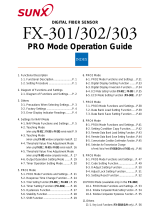
en_BA_FNDx14_FHDx14_IO.doc 2/14 Baumer Electric AG
12.04.2013/hem Frauenfeld, Switzerland
Operating Instructions for Series 14 Hygienic and Washdown
Design with IO-Link
Contents
1
General information ..................................................................................................................... 3
1.1
Concerning the contents of this document ..................................................................................... 3
1.2
General information ........................................................................................................................ 3
2
IO-Link introduction ..................................................................................................................... 4
2.1
SIO mode ........................................................................................................................................ 4
2.2
IO-Link communication mode ......................................................................................................... 4
2.3
IODD (IO-Link device description) .................................................................................................. 5
3
Sensor in SIO mode ..................................................................................................................... 5
4
Sensor in IO-Link communication mode ................................................................................... 5
4.1
Process data ................................................................................................................................... 5
4.1.1
Process data structure .................................................................................................................... 5
4.2
Parameters and commands ........................................................................................................... 6
4.2.1
Product data ................................................................................................................................... 6
4.2.2
Parameters ..................................................................................................................................... 6
4.2.3
Commands ..................................................................................................................................... 6
4.2.4
Saving changes .............................................................................................................................. 6
5
Explanation of sensor configuration .......................................................................................... 7
5.1
Teach-in of a user-specific switching point ..................................................................................... 7
5.1.1
Parameters ..................................................................................................................................... 7
5.1.2
Commands ..................................................................................................................................... 7
5.1.3
Description ...................................................................................................................................... 7
5.1.4
Hysteresis ..................................................................................................................................... 10
5.1.5
Error correction ............................................................................................................................. 10
5.2
Dirt indicator .................................................................................................................................. 10
5.2.1
Parameters ................................................................................................................................... 10
5.2.2
Description .................................................................................................................................... 10
6
Configuration .............................................................................................................................. 12
6.1
Table of general parameters ......................................................................................................... 12
6.2
Table of work parameters ............................................................................................................. 12
6.3
Table of system commands .......................................................................................................... 13
6.4
Table of error codes ...................................................................................................................... 13
6.5
Table of factory settings ................................................................................................................ 13















